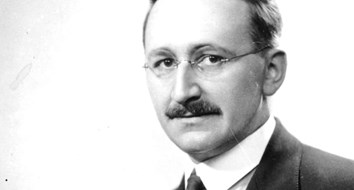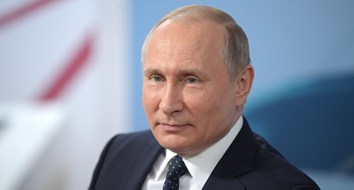Next month’s 400th anniversary of the Pilgrims’ landing in New England will prompt renewed interest in their story—the flight from religious persecution in England, the long interim in friendly Holland, the trans-Atlantic voyage aboard the famed Mayflower, the ill-fated experiment in communal socialism, the remarkable governing document known as the Mayflower Compact, and more.
If you visit Plymouth, Massachusetts to see Pilgrim-related sites, you should not miss the Mayflower II, a full-size replica of the original vessel. Its much more recent story is almost as fascinating as that of its 17th century counterpart and every bit the tribute to private initiative that the first one was. Enter a remarkable man named Warwick Charlton.
Born in London in March 1918, Charlton found himself working a quarter century later as a press officer for Field Marshal Bernard Montgomery in North Africa as Allied troops battled the Nazis. At war’s end, Charlton was aboard an American troopship bound for England when he picked up and read the only available book on the boat. It was Of Plymouth Plantation 1620-1647, by the Plymouth colony’s governor, William Bradford. An idea popped into his head that quickly morphed into an obsession: Why not show appreciation for America’s contribution to the war effort by presenting them with a facsimile of the Mayflower?
The Pilgrim expedition in 1620, ship and all, was financed privately as detailed in Bhu Srinivasan’s 2018 FEE article, and so was Charlton’s replica. It wasn’t easy, as Douglas Martin noted in a New York Times story in 2002:
Mr. Charlton had no money of his own but raised what would today be the equivalent of several million dollars. He fought on despite angry creditors, striking shipyard workers, jealous keepers of the Pilgrims' torch in Massachusetts and ingrates who suggested his motives were less than pure—meaning commercial. He loved the whole glorious mess.
For more than a decade as he held jobs in the publishing and broadcasting businesses, Charlton shook the bushes for donations. Almost everybody he talked to in Britain endorsed the idea but then didn’t come through with a check. So he came up with creative stunts such as selling “treasure chests” of British products that would be opened when his dream ship anchored in America. He even convinced the Mayflower Moving Company in the US. to contribute to the rebuilding in exchange for certain promotional rights. He eventually secured additional support (including necessary historical research and architectural design) from the foundation that maintains the Pilgrim site in Plymouth, Massachusetts.
In its obituary for Charlton after he died in 2002, The Telegraph in London recounted his efforts:
An initial budget estimate of £280,000 was soon doubled. Charlton begged rope builders, sailmakers and timber merchants for material in return for a chance to associate their name with the project. As soon as building commenced, he erected a barrier at the entrance to the shipyard with a notice that read: “Come and look round the hull of Mayflower II. Entrance fee: two shillings.” By the time the ship set sail, 245,000 people had paid to watch the work in progress. In all, Charlton managed to persuade 200 industrial, commercial, and individual sponsors to help to finance the project.
Mere similarity to the original Mayflower was not sufficient for Charlton. Once he had raised enough money, which took a decade, he aimed to construct a precise replica of the 183-ton ship. He insisted that the shipbuilder use tools and materials identical to those of the 17th century, such as English oak. He even required the builder himself, Stuart Upham, to travel on the replica’s eventual voyage to America and guarantee its seaworthiness.
On April 20, 1957, the completed Mayflower II set sail for Massachusetts from Brixham in southwest England. Aboard was Charlton and a crew of 33 dressed as Pilgrims. In spite of a violent storm at sea and an unexpected slashing of the beer ration, the voyage consumed just 54 days—11 fewer than the first one. Upon arrival, the vessel and crew were greeted by a throng of 100,000 including two men who would soon be presidential competitors, Vice President Richard Nixon and Senator John F. Kennedy. You can watch two videos about the 1957 voyage here and here and even take a virtual tour of the ship here.
Recently restored for the upcoming 400th anniversary ceremonies, Mayflower II still resides today near famed Plymouth Rock where Warwick Charlton left it over six decades ago. He himself visited almost annually for many years, joining the line of tourists and quietly amusing himself as so many thought they were gazing upon the original.
Mayflower II was Warwick Charlton’s way—privately, enthusiastically and without harming any taxpayers—of proclaiming his gratitude to America. He gifted the ship to America for the nominal “fee” of $1.00.
Thank YOU, Mr. Charlton!
For additional information, see:
The Pilgrims in Holland by Robert A. Peterson
Why the Pilgrims Abandoned Common Ownership for Private Property by Lawrence W. Reed
Who Paid for the Mayflower? By Bhu Srinivasan
The Puritan Experiment in Common Ownership by Gary North
Our First Thanksgiving by Sartell Prentice Jr.
No Thanksgiving Without the Profit Motive by Lawrence W. Reed
Warwick Charlton, a Dreamer, Dies at 84 by Douglas Martin
Warwick Charlton (obituary in The Telegraph)





